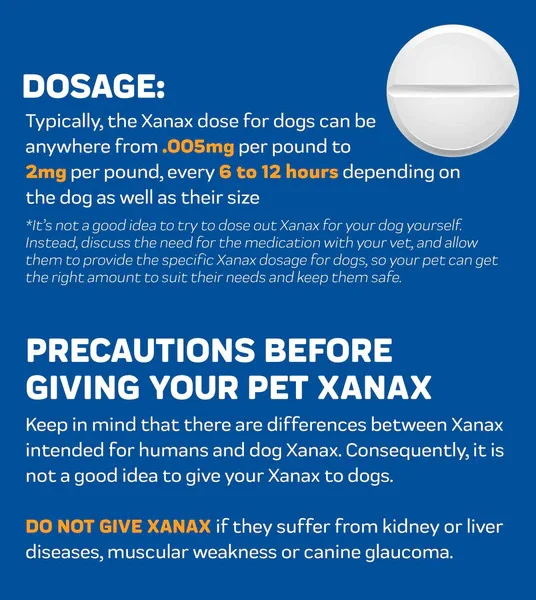Xanax For Dogs: Dogs are susceptible to many of the same health problems as the people they adore the most. Storms and your absence can both be triggers for anxiety in dogs, which is a particularly common condition in these animals.
If your dog is experiencing anxiety, you may try everything in your power to alleviate its symptoms and make them feel better. People frequently turn to prescription medications in order to treat the same kinds of issues that are found in humans.
Also Read: Why Is My Dog’s Tongue Turning Purple?
The use of Xanax for dogs can be helpful, but it is not without its associated dangers. In this section, we will explain what the effects of Xanax are, how and when it should be administered to your dog and some safer alternatives that you can test out first.
What Is Xanax?
Xanax is a brand name for the anti-anxiety medication alprazolam. The medication is approved for use by the Food and Drug Administration (FDA) to treat a variety of anxiety disorders and panic attacks. The medication is a controlled substance, which means it requires a prescription from a qualified Vet so as to use it.
Xanax is part of a group of drugs known as benzodiazepine tranquilizers. Benzodiazepine tranquilizers are a class of drugs that act on the central nervous system to produce a calming effect. They work by increasing the activity of a neurotransmitter called gamma-aminobutyric acid (GABA).
GABA is a kind of neurotransmitter that constrains nerve transmission in the brain. This results in a calming effect. Benzodiazepines like Xanax can be used to treat anxiety, panic attacks, and seizures. They can also be used to help people sleep or to relieve muscle spasms.
Benzodiazepines are generally safe and effective when used as directed. However, they can cause side effects, including drowsiness, dizziness, and impaired coordination. They can also be addictive.
If you have been prescribed Xanax, it is important to take it as directed by your doctor also do not stop taking Xanax abruptly, as this can cause withdrawal complications.
If you think you may have a problem with Xanax or other benzodiazepines, talk to your doctor. There are treatments available that can help you safely stop taking the medication.
Is Xanax safe for my dog?

Is Xanax Safe for My Dog? As a pet owner, it’s only natural to want to do everything in your power to keep your furry friend safe and healthy. When it comes to medications, however, it’s important to be extra careful – after all, what’s safe for humans isn’t necessarily safe for dogs. So, is Xanax safe for dogs?
Here’s what you need to know.
Yes, you can give your dog Xanax, but as with most prescription medications, proper dosing is important. You should not give your dog Xanax without veterinary approval and monitoring.
There are potential dangers associated with Xanax use in dogs. It is a potent medication that has the potential to cause side effects, including problems with the kidneys and the liver. If your dog suffers from kidney disease or liver conditions, you should not give him or her Xanax. In addition, Xanax can cause dogs to experience a decrease in their motor function or coordination, as well as fatigue and an increase in their appetite. There is a possibility that some dogs will act aggressively or become overly excited.
How Does Xanax Work?
Xanax works by binding to GABA receptors in the brain. GABA is a neurotransmitter that plays a role in regulating nerve cell activity. When Xanax binds to GABA receptors, it increases the effects of GABA, leading to a calming effect.
What are the Side Effects of Xanax in Dogs?

Withdrawal is one of the most critical side effects of Xanax. When given Xanax over an extended period of time, a dog runs the risk of becoming dependent on the medication. If you suddenly stop giving your dog Xanax, it is possible that it will experience withdrawal symptoms such as shaking, vomiting, and even aggression. In order to avoid the problems that are associated with dependence on Xanax, only take it as directed or look into other options.
The most common side effects of Xanax in dogs include:
- Drowsiness
- Lethargy
- Loss of coordination
- Inability to stand
- Difficulty walking
Xanax can also cause other side effects, including:
- Vomiting
- Diarrhea
- Constipation
- Decreased appetite
- Dry mouth
- Increased thirst
- Urinary retention
What are the Risks of Giving Xanax to Dogs?
While Xanax is generally safe for dogs, there are a few risks to be aware of.
One of the biggest risks is that Xanax can cause severe drowsiness and even coma in dogs. For this reason, it’s important to only give Xanax to your dog under the supervision of a veterinarian.
Xanax can also interact with other medications, so it’s important to tell your veterinarian about all medications your dog is taking, including over-the-counter drugs and supplements.
Lastly, Xanax can be addictive, so it’s important to only give it to your dog as directed by a veterinarian.
Xanax is a safe and effective medication for dogs when used as directed by a veterinarian. If you have any questions or concerns about giving Xanax to your dog, be sure to talk to your vet.
Other Treatment Options Than Xanax for Dogs
You don’t necessarily need to reach for prescription-strength treatments like Xanax in order to help your dog cope with anxiety; there are many other options available. If your dog is unable to tolerate Xanax, you may want to consider trying one of the many other medications available to treat anxiety in dogs, such as clomipramine.
- Massage is yet another technique that can be used to help calm an anxious dog. Affectionate touch, such as a gentle massage, can help increase calm, reduce tension, and boost your dog’s mood. This can be accomplished by massaging your dog’s muscles. You have the option of giving your dog a massage yourself, or you can take them to a pet massage specialist.
- By providing your dog with plenty of opportunities for exercise and mental stimulation, you can help alleviate your dog’s feelings of boredom and protect him from destructive behavior. Modifying the dog’s behavior in this way has the potential to make a significant improvement for dogs that also suffer from separation anxiety. Your pet will have less time to worry about getting into mischief or acting naughty if you keep it distracted with toys and activities.
- When there is a thunderstorm or loud noises outside, another option is to use distractions like playing fetch with your dog. By diverting your pet’s attention away from the stressful situation at hand, you can keep them from becoming overly worked up about it.
- The use of dog calming chews, which typically include calming ingredients such as CBD oil, valerian root, and chamomile, is another fantastic method for lowering stress levels. It’s possible that these components can offer similar calming effects to prescription medications, but without the potentially harmful side effects.
Conclusion
In conclusion, it is apparent that there are pros and cons to using Xanax for dogs. While it is definitely safe to use for some animals, there are also some risks that need to be taken into account when prescribing this medication.


